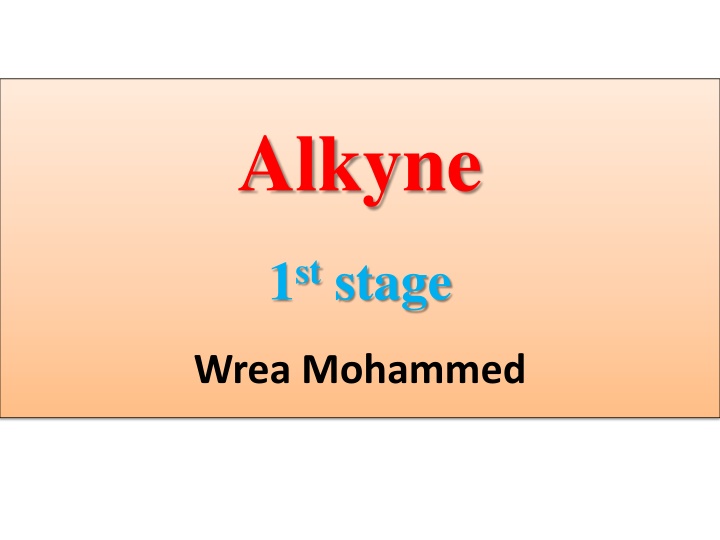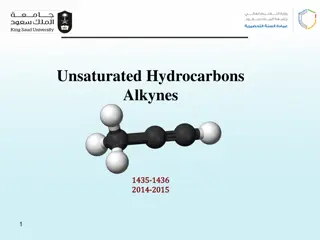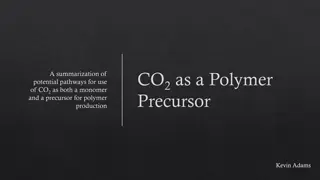
Discovering Alkynes: Properties, Nomenclature, and Industrial Uses
Explore the world of alkynes, unsaturated and highly reactive compounds containing carbon-carbon triple bonds. Learn about terminal and internal alkynes, their unique characteristics, naming conventions, and industrial applications. Discover the fascinating properties that make alkynes versatile in various chemical reactions and industrial processes.
Download Presentation

Please find below an Image/Link to download the presentation.
The content on the website is provided AS IS for your information and personal use only. It may not be sold, licensed, or shared on other websites without obtaining consent from the author. If you encounter any issues during the download, it is possible that the publisher has removed the file from their server.
You are allowed to download the files provided on this website for personal or commercial use, subject to the condition that they are used lawfully. All files are the property of their respective owners.
The content on the website is provided AS IS for your information and personal use only. It may not be sold, licensed, or shared on other websites without obtaining consent from the author.
E N D
Presentation Transcript
Alkyne 1st stage Wrea Mohammed
Alkyne Alkynes contain a carbon carbon triple bond. Terminal alkynes has the triple bond at the end of the carbon chain, so that a hydrogen atom is directly bonded to a carbon atom of the triple bond. Internal alkynes has a carbon atom bonded to each carbon atom of the triple bond.
Alkyne A triple bond consists of a bond and two bonds. The general formula for the alkynes is CnH2n-2. They are unsaturated and highly reactive compounds. Each carbon of a triple bond is sp hybridized and linear, and all bond angles are 180 .
Both bonds of a C C triple bond are weaker than a C C bond, making them much more easily broken. As a result, alkynes undergo many addition reactions. Alkynes are more polarizable than alkenes because the electrons in their bonds are more loosely held.
Nomenclature of Alkyne Alkynes are named in the same way that alkenes In the IUPAC system, change the -ane ending of the parent alkane to the suffix -yne. Choose the longest carbon chain that contains both atoms of the triple bond and number the chain to give the triple bond the lower number.
Compounds with two triple bonds are named as diynes, those with three are named as triynes, and so forth. Compounds with both a double and a triple bond are named as enynes. The chain is numbered to give the first site of unsaturation (either C=C or C C) the lower number.
The simplest alkyne, HCCH, named in the IUPAC system as ethyne, is more often called acetylene, its common name. The two-carbon alkyl group derived from acetylene is called an ethynyl group (HC C ). An important use of acetylene is in oxyacetylene gas welding. The fuel gas burns with oxygen in a torch. An incredibly high heat is produced, and this is enough to melt metal.
Industrial uses of alkynes Ethynes are industrially used as a starting material for polymers, e.g. plastic piping, Teflon and acrylics. Polymers are large molecules, which are prepared by linking many small monomers. Polyvinyl chloride, also commonly known as PVC, is a polymer produced from the polymerization of vinyl chloride.
Physical properties of alkynes Alkynes have low melting points and boiling points. Melting points and boiling points increase as the number of carbons increases. Alkynes are soluble in organic solvents and insoluble in water because they have low polarity .
Preparation of alkynes Alkynes are prepared from alkyl dihalides via elimination of atoms or groups from adjacent carbons. A strong base removes two equivalents of HX from a vicinal or geminal dihalide to yield an alkyne
Reactions of Alkynes: Alkynes undergo addition reactions because they contain weak bonds. Two sequential reactions take place. Addition of one equivalent of reagent forms an alkene, which then adds a second equivalent of reagent to yield a product having four new bonds.
Addition Reactions Two molecules of reagent are needed for each triple bond.
1- Addition of Hydrogen Halides Alkynes undergo hydrohalogenation, the addition of hydrogen halides, HX (X = Cl, Br, I). Two equivalents of HX are usually used: addition of one mole forms a vinyl halide, which then reacts with a second mole of HX to form a geminal dihalide.
2- Addition of Halogen Halogens, X2 (X = Cl or Br), add to alkynes in much the same way they add to alkenes. Addition of one mole of X2 forms a trans dihalide, which can then react with a second mole of X2 to yield a tetrahalide.
3- Addition of Water In the presence of strong acid or Hg2+ catalyst, the elements of H2O add to the triple bond, but the initial addition product, an enol, is unstable and rearranges to a product containing a carbonyl group that is, a C=O. A carbonyl compound having two alkyl groups bonded to the C=O carbon is called a ketone.
4- Addition of hydrogen A catalysts such as palladium is normally needed for this reaction.






















